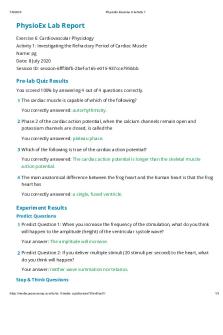Physio Ex Exercise 6 Activity 4 PDF

| Title | Physio Ex Exercise 6 Activity 4 |
|---|---|
| Author | Rachael Villaran |
| Course | Human Physiology |
| Institution | Georgia State University |
| Pages | 5 |
| File Size | 258.8 KB |
| File Type | |
| Total Downloads | 84 |
| Total Views | 149 |
Summary
Download Physio Ex Exercise 6 Activity 4 PDF
Description
9/10/2020
PhysioEx Exercise 6 Activity 4
PhysioEx Lab Report Exercise 6: Cardiovascular Physiology Activity 4: Examining the Effects of Chemical Modifiers on Heart Rate Name: Rachael Villaran Date: 10 September 2020 Session ID: session-7be6053e-8409-8bd0-e961-8b45cfbdf921
Pre-lab Quiz Results You scored 100% by answering 4 out of 4 questions correctly. 1 The parasympathetic nervous system releases __________ to affect heart rate. You correctly answered: acetylcholine. 2 A cholinergic drug that worked the same as acetylcholine would You correctly answered: be an agonist and decrease heart rate. 3 Norepinephrine affects the heart rate by You correctly answered: increasing the rate of depolarization and increasing the frequency of action potentials. 4 The __________ receptor binds norepinephrine and epinephrine. You correctly answered: ß-1 adrenergic.
Experiment Results Predict Questions 1 Predict Question 1: Pilocarpine is a cholinergic drug, an acetylcholine agonist. Predict the effect that pilocarpine will have on heart rate. Your answer: Pilocarpine will decrease heart rate. 2 Predict Question 2: Atropine is another cholinergic drug, an acetylcholine antagonist. Predict the effect that atropine will have on heart rate. Your answer: Atropine will have no effect on heart rate. Stop & Think Questions 1 Which of the following is true of epinephrine?
https://media.pearsoncmg.com/bc/bc_0media_ap/physioex/10/ex6/act4/
1/5
9/10/2020
PhysioEx Exercise 6 Activity 4
You correctly answered: It increases the heart rate and mimics the sympathetic nervous system. 2 The final chemical modifier we will look at is digitalis (also known as digoxin and digitoxin and derived from the foxglove plant). Individuals with weakened hearts need to allow maximum time for venous return and increased stroke volume and would therefore most likely benefit from You did not answer this question. Correct answer: increased force of contraction and decreased heart rate. Experiment Data Solution
Heart Rate (beats/min)
----
62
Epinephrine
82
Pilocarpine
47
Atropine
73
Digitalis
43 ----
Epinephrine
https://media.pearsoncmg.com/bc/bc_0media_ap/physioex/10/ex6/act4/
2/5
9/10/2020
PhysioEx Exercise 6 Activity 4
Pilocarpine
Atropine
Digitalis
https://media.pearsoncmg.com/bc/bc_0media_ap/physioex/10/ex6/act4/
3/5
9/10/2020
PhysioEx Exercise 6 Activity 4
Post-lab Quiz Results You scored 100% by answering 4 out of 4 questions correctly. 1 Pilocarpine decreased the heart rate. Typical of cholinergic agonists, it You correctly answered: decreased the frequency of action potentials. 2 The effect of atropine was to You correctly answered: mimic the sympathetic nervous system. 3 The modifiers tested that decrease the heart rate were You correctly answered: digitalis and pilocarpine. 4 To increase the heart rate, the best choices would be You correctly answered: epinephrine and atropine.
Review Sheet Results 1 Describe the effect that pilocarpine had on the heart and why it had this effect. How well did the results compare with your prediction? Your answer: I was right and said it would decrease the heart rate. 2 Atropine is an acetylcholine antagonist. Does atropine inhibit or enhance the effects of acetylcholine? Describe your results and how they correlate with how the drug works. How well did the results compare with your prediction?
https://media.pearsoncmg.com/bc/bc_0media_ap/physioex/10/ex6/act4/
4/5
9/10/2020
PhysioEx Exercise 6 Activity 4
Your answer: Atropine increased heart rate as I predicted. 3 Describe the benefits of administering digitalis. Your answer: Administering digitalis helps, inhibits or imitates the action of acetylcholine. So it can be used to control body. 4 Distinguish between cholinergic and adrenergic chemical modifiers. Include examples of each in your discussion. Your answer: Cholinergic inhibits, mimics or enhances the action of acetylcholine. This includes Pilocarpine and Digitalis. Adrenergic inhibits, mimics, or enhances the action of epinephrine. This includes atropine.
https://media.pearsoncmg.com/bc/bc_0media_ap/physioex/10/ex6/act4/
5/5...
Similar Free PDFs

Physio Ex Exercise 6 Activity 4
- 5 Pages

Physio Ex Exercise 6 Activity 4
- 5 Pages

Physio Ex Exercise 6 Activity 4
- 5 Pages

Physio Ex Exercise 6 Activity 4
- 4 Pages

Physio Ex Exercise 6 Activity 4
- 5 Pages

Physio Ex Exercise 4 Activity 4
- 3 Pages

Physio Ex Exercise 4 Activity 4
- 3 Pages

Physio Ex Exercise 4 Activity 4
- 3 Pages

Physio Ex Exercise 6 Activity 1
- 3 Pages

Physio Ex Exercise 5 Activity 6
- 3 Pages

Physio Ex Exercise 6 Activity 1
- 3 Pages

Physio Ex Exercise 6 Activity 3
- 3 Pages

Physio Ex Exercise 6 Activity 3
- 3 Pages

Physio Ex Exercise 2 Activity 6
- 6 Pages

Physio Ex Exercise 6 Activity 5
- 4 Pages

Physio Ex Exercise 5 Activity 6
- 3 Pages
Popular Institutions
- Tinajero National High School - Annex
- Politeknik Caltex Riau
- Yokohama City University
- SGT University
- University of Al-Qadisiyah
- Divine Word College of Vigan
- Techniek College Rotterdam
- Universidade de Santiago
- Universiti Teknologi MARA Cawangan Johor Kampus Pasir Gudang
- Poltekkes Kemenkes Yogyakarta
- Baguio City National High School
- Colegio san marcos
- preparatoria uno
- Centro de Bachillerato Tecnológico Industrial y de Servicios No. 107
- Dalian Maritime University
- Quang Trung Secondary School
- Colegio Tecnológico en Informática
- Corporación Regional de Educación Superior
- Grupo CEDVA
- Dar Al Uloom University
- Centro de Estudios Preuniversitarios de la Universidad Nacional de Ingeniería
- 上智大学
- Aakash International School, Nuna Majara
- San Felipe Neri Catholic School
- Kang Chiao International School - New Taipei City
- Misamis Occidental National High School
- Institución Educativa Escuela Normal Juan Ladrilleros
- Kolehiyo ng Pantukan
- Batanes State College
- Instituto Continental
- Sekolah Menengah Kejuruan Kesehatan Kaltara (Tarakan)
- Colegio de La Inmaculada Concepcion - Cebu